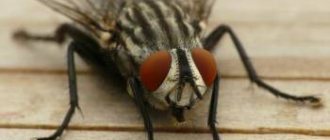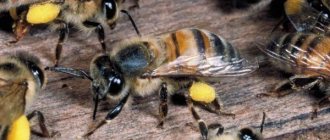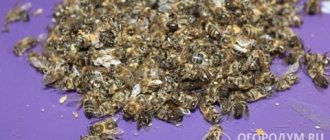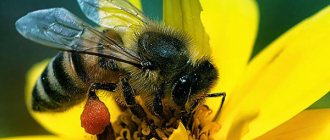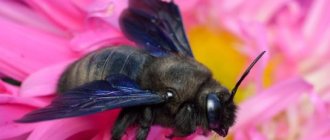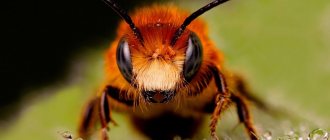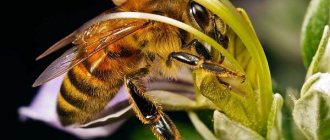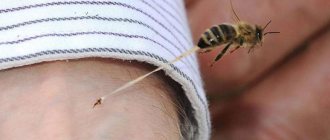- Blog articles
- Bees
Beekeeping
Economics of beekeeping
Beekeeping news in Russia
Beekeeping news in the world
Honey
Propolis
Bee bread
Zabrus
Royal jelly
In the world about bees
Apiary
Bees
News from honey fairs
From the history of beekeeping
- What is the structure of a bee's eyes?
- Features of the eyes of the queen, drone, worker bee
- Bee vision mechanism
- The location and number of eyes of a bee
- Why exactly so many eyes?
- Color perception of the world through the eyes of bees
- Can bees see in the dark?
- What happens if you blind a bee with a bright light?
What is the structure of a bee's eyes?
To the unusual question about how many eyes a bee has, we immediately answer: “There are only five eyes, 3 simple, and 2 complex, consisting of facets.” Bees have a complex visual system. It unites various organs of the visual apparatus, which are responsible for performing certain functions.
Such organs help bees navigate in space, compensate for insufficient illumination, and allow them to smell flowering at a distance of up to 1 km. They are not only responsible for the perception of the environment, but also perform additional functions. The working honey bee has eyes with a complex structure on the sides of its head. They are formed by a huge number of special cells. They are called facets. Bees see their surroundings as a mosaic made up of tiny particles. Each facet is responsible for forming its own part of the picture.
Bee visual system
To identify the right honey plant, nature endowed the soft-bodied worker with complex visual organs. So how many eyes does a bee have? They consist of two compound and three simple eyes.
Compounded eyes of the winged worker
Bee eyes
The surface of the compound eye is covered with a chitinous membrane, which plays the role of a protective shell. Examining under high magnification, you can see small areas of a certain shape, which are called facets. That’s why it got its name – compound eye.
A cone-shaped crystalline formation is adjacent to the facet. It collects directly directed rays and conducts them to the retina. Each formation, together with the facet and adjacent retinal rod, constitutes an ommatidium.
The number of these complex compounds varies among bees. The queen does not leave the nest, so she has the least of all - 3000 - 4000. The worker bee looks for honey plants 4000 - 5000. The drone has a difficult task of finding the queen, he has from 7000 to 10000 ommatidia.
The ommatidia are located at a slight angle relative to each other. Each of them looks in its own direction. All tubes are covered with a black shell that does not transmit light. The rays, entering the cone-shaped connection, do not all reach the retina, but only one, which enters the ommatidium at a right angle.
All other rays are absorbed by the dark shell. Therefore, the bee's brain receives direct information from each tube. These cones act as separate eyes, collecting the information they see from the mosaic into one whole. And the more there are, the more detailed and clear the picture will be.
Bees' vision
The eyes are fixed in one position, so during flight the information entering the brain changes quickly. This property helps her better navigate in motion, sharply change the direction of flight, avoiding collisions.
The human eye is capable of receiving 22–25 flickers in one second, and a bee’s eye up to 300. Therefore, what we see is perceived by insects as slow motion, which also makes orientation easier.
The facet consists of lenses, optic cells and pigment cells. The capabilities of lenses are similar to those of a camera lens. The rays pass through them and produce an image located directly in front of the facets.
The area of each individual eye is very small, but due to the convexity of the eye and the large number of ommatidia, a lot of information enters the insect’s brain.
A bee's field of vision consists of the sum of the fields of facets (as in a mosaic). Because of this, it is called mosaic. This perception is adapted to flight.
simple eye
How many eyes does a bee have?
All these details work, just like in a compound eye, only somewhat primitively. They do not distinguish objects, but are used to detect light.
These eyes of the honey bee and their queen are located on the crown of the head and are not very visible. The drone's compound eyes are large, so they converge on the crown, and simple eyes are shifted to the forehead.
Features of the eyes of the queen, drone, worker bee
If you compare the visual organs of bees of different classes, you will find differences. The worker bee has simple eyes located on the crown of the head. In contrast, in the drone and queen bee such organs are located directly on the forehead. Insects have different numbers of facets (ommatidia). In queen bees their number often reaches 4,000, in worker bees - 5,000, in drones - 9,000.
The compound eyes are clearly visible in drones, since they converge on the crown of the head. In the queen bee and worker bee, it is difficult to distinguish these visual organs at a superficial glance. In all the insects described, simple ocelli have a primitive structure. These are special transparent lenses; they protrude significantly from the head. Each of them separately captures images.
Sting
Bee sting
Worker bees and the queen are provided with a special defensive organ - the sting. It is absent in males. The sting appeared in the process of evolution in many species of Hymenoptera insects. It is located at the end of the bee's abdomen. When the insect is in a calm, relaxed state, the sting is hidden and exposed at the moment of danger. Inside it are 3 systems of glands in the form of tubes. They produce poison that accumulates in the reservoir.
After the worker bee releases its sting, it dies. The queen uses a sting to lay eggs.
A bee colony consists of a queen, worker bees and drones. They are different in shape and size, but there are almost no differences in the structure of their bodies. The head, chest and abdomen are the main components of the bee's body. Each of these parts has its own design. Many people are interested in the question of how many eyes, legs, wings, etc. a bee has.
Bee vision mechanism
If you look closely at compound eyes using a magnifying loupe, you will notice hexagonal embossing on the surface of each organ. Because of this specific embossing, the eyes are often called mesh. Any of the facets is a bundle, which consists of cells that have an elongated shape and a thin border. Between adjacent eyes there are special pigment cells.
The presence of thousands of facets does not provide bees with good vision. Regardless of environmental conditions, the image of objects remains insufficiently clear. It is divided into separate points. The special design of the binocular system imposes its own limitations. It has been proven that the eyes of bees are more adapted to the perception of objects that are in motion, in a state of flight. Vision does not cope well with the perception of objects that are motionless and do not change their location.
The visual information that bees perceive through their eyes is instantly converted into nerve impulses. They immediately enter the brain. There, first the analysis takes place, and then the processing of the received information. After the response is generated by the central part of the nervous system, the signal is transmitted to peripheral organs. Insect vision is characterized by three-dimensionality and blurred images.
How bees find flowers by their colors
While flying at a speed of 25–30 km per hour, bees are unable to see colors. Only when they slow down and approach the desired object do their color vision turn on. As stated earlier, the hairs located on the facet organs of vision vibrate to the electric field that the flower emits, because flowers attract insects not only by their bright color, but also by the heat or electricity that affects the nervous system. Moreover, in plants the field is negative, and in working individuals it is positive. And as a result, a charge occurs between them, passing through the hairs.
Did you know? If you move the hive from one place to another, the arriving bee will go to its original home.
The eye of a bee is a very complex and unique organ, thanks to which the insect perceives the outside world quite comfortably and performs its function 100%.
The location and number of eyes of a bee
Regardless of the class of the insect (worker bee, drone, queen bee), it has five eyes. On the head of any individual are located:
- three small dorsal ocelli (ocelli);
- two large eyes with a complex structure.
The eyes of the second type are called facet eyes because they are located on the sides of the head and are formed from a huge number of facets. Such organs of vision have an oblong shape. They are bulges that point downwards.
Compounded eyes are formed from ommatidia - these are structural units. They are densely located, neighboring ommatidia are closely adjacent to each other. Each of these functional units that make up the facet organ has a refractive, insulating and receptive part.
Interestingly, the size of each honey bee eye is on average 2 millimeters. Moreover, the number of eyes remains unchanged for each individual. The visual organs of drones have the most significant area; the second place according to this criterion is occupied by working individuals, and the uterus closes the list.
Why exactly so many eyes?
Hardworking bees initially have a poorly developed visual apparatus. To compensate for their underdeveloped vision, nature has endowed them with several organs of vision. As many as five eyes allow these insects to navigate their surroundings, receive information about flowering plants, and see various objects. Large eyes help to see objects and form a holistic picture of what is happening around the insect.
The dorsal organs (ocelli) are responsible for twilight vision. They help bees learn about the approach of dawn and the onset of a new day, as well as accurately receive information about its end. Ocelli partially replace the sense of touch; they have a secondary function as part of the binocular system. The facet organs form images in the form of a mosaic, which consists of individual points and helps to obtain a holistic view of objects.
Compounded eyes with a complex structure are used as the main part of the visual apparatus. In contrast, simple eyes are considered a secondary element. They provide bees with objective information about the surrounding space.
Color perception of the world through the eyes of bees
Such insects distinguish many colors and shades. Only they do not perceive the color red, they cannot distinguish it from black. By the way, this is why all winter inspections of bees are carried out using a red flashlight; bees do not see light, which means they are less worried. Bees' images of the surrounding world are formed in the ultraviolet spectrum.
conclusions
- The color of the entire hive is not decisive for the spatial orientation of bees. For this reason, all hives in the apiary can be painted with the same color paint. To prevent overheating of the hives, these should be light colors, for example, light gray, light blue, light yellow, etc.
- Taking into account the visual characteristics of bees (they are myopic), the role of a “near drive” for getting into the entrance can be played by painting only a small section of the front wall of the hive with a height of 100-150 mm at the main entrance in colors visible to the bee. These colors can be blue (white), yellow, green, orange and “aluminum” color (metallic powder on nitro varnish).
Video: This is how bees see
Adults perceive shades of white, blue and yellow best. The vision of adults can be called mosaic. Their brains do a lot of work when forming an image. The whole process looks like this:
- Each of thousands of facets perceives only one part of an object, and not the entire object.
- The brain processes incoming images depicting individual parts of an object.
- In the brain, individual parts of an object merge, and as a result, worker bees perceive the whole picture.
Bees do not see much difference between orange, green, light green and yellow colors. The visual apparatus of bees has the ability to perceive polarized light. This quality allows insects to calmly navigate in space.
What to do when relocating bee colonies?
Often in the process of work, especially at the beginning of summer, beekeepers have to move nests from one house to another. This occurs when bee colonies unite or divide.
It is extremely difficult to carry out such work without a supply of hives of the required color, because insects, accustomed to the color of their hive, are reluctant to go to other houses.
A little trick will help here. It is necessary to cut several sheets of plywood exactly to the size of the front wall of the house. Taphole slits are cut in the sheets at the bottom.
The blanks are made in two colors: one side is yellow and the other is blue. Accordingly, all bee houses in the apiary are painted only with yellow and blue paint.
When moving bee colonies from a blue hive to a yellow one, the plywood is turned outward with the blue side, installed on the landing board and attached to the front wall in any way convenient for the beekeeper.
The same must be done when moving bees from a yellow house to a blue one, with the only difference being that the plywood will face outward with the yellow side.
Insects are easily deceived and willingly flock to a new house, which now has a color that is familiar to them.
The method works great when dividing nests for half a year or combining bee colonies. And he came to us from V.F. Stepurina from the city of Ulyanovsk. For which special thanks to him.
Video: A look at the apiary through the eyes of a bee
It is worth noting that worker bees rarely fly in the dark, with rare exceptions. This is caused not only by the need for night rest, but also by a decrease in the strength of the electromagnetic field. This factor contributes to the disruption of spatial orientation in bees, so they generally prefer not to fly at night. Experimentally, it was possible to find out that these insects are able to distinguish the shapes of objects.
Plastic shields
Nomadic apiaries directly depend on maneuverability in work. The fewer tools and necessary equipment you have to carry with you, the easier it is for beekeepers. And the large size of apiaries makes the choice of paint shade limited.
You can solve the problem by using small pieces of multi-colored plastic measuring 15 by 25 centimeters. Moreover, all bee houses have the same color, for example, light blue, which simplifies and reduces the range of colors in beekeeping. As a result, it will be easier to touch up hives that have faded over time.
The shields are hung near the entrance slots. When replacing bodies or hives, they are removed and re-hung in their original places. That is, a minimum of effort is required from the beekeeper to facilitate the orientation of the bees in space.

